Promoting the Sustainable Development of Industrial Heritage Tourism Through Digital Intelligence: User Acceptance and Interface Design Research
Abstract
1. Introduction
- What key factors influence users’ intention to adopt digital intelligence industrial heritage tourism platform in the context of WISCO?
- How does technology anxiety affect users’ acceptance mechanisms within industrial heritage tourism platforms?
- How can the design framework guided by the UTAUT2-based model optimize digital interaction and interface experience, thereby enhancing visitor engagement and promoting industrial heritage conservation and cultural transmission?
2. Literature Review and Research Hypotheses
2.1. Industrial Heritage Tourism
2.2. Intelligent and Digital Technologies Empowering Cultural Heritage Tourism
2.3. Application of the UTAUT2 Model in the Field of Cultural Heritage
2.4. The Mediating Role of Performance Expectation
3. Research Methodology
3.1. Research Procedure
3.2. Questionnaire Design and Data Collection
3.3. Descriptive Statistical Analysis
3.4. Reliability and Validity Tests
4. Research Results
4.1. Correlation Analysis
4.2. Discriminant Validity Among Variables
4.3. Structural Equation Model
4.4. Mediation Effect
4.5. Design Strategies for the WISCO Industrial Heritage Tourism Platform Based on the UTAUT2 Model
4.5.1. Technological Adaptation: Enhancing Platform Usability and Functionality
4.5.2. Emotional Resonance: Enhancing Users’ Emotional Identification and Cultural Experience
4.5.3. Behavioral Guidance: Promoting Continuous Engagement and Behavioral Conversion
4.6. Design Object
4.7. Platform Functional Architecture Design
4.7.1. Functional Modules
4.7.2. Technology Integration
4.8. Platform Interface Design Based on the UTAUT2 Model
4.9. Design Validation
5. Discussion and Conclusions
5.1. Research Discussion
5.2. Theoretical Contributions and Practical Implications
5.2.1. Theoretical Contributions
5.2.2. Practical Implications
5.3. Research Limitations and Future Directions
5.4. Conclusions
Author Contributions
Funding
Institutional Review Board Statement
Informed Consent Statement
Data Availability Statement
Conflicts of Interest
References
- UNESCO. Culture 2030 Indicators; UNESCO: Paris, France, 2019. [Google Scholar]
- Li, J.; Peng, X.; Liu, X.; Tang, H.; Li, W. A study on shaping tourists’ conservational intentions towards cultural heritage in the digital era: Exploring the effects of authenticity, cultural experience, and place attachment. J. Asian Archit. Build. Eng. 2025, 24, 1965–1984. [Google Scholar] [CrossRef]
- Edwards, J.A.; i Coit, J.C.L. Mines and quarries: Industrial heritage tourism. Ann. Tour. Res. 1996, 23, 341–363. [Google Scholar] [CrossRef]
- Ifko, S. Comprehensive Management of Industrial Heritage Sites as A Basis for Sustainable Regeneration. Procedia Eng. 2016, 161, 2040–2045. [Google Scholar] [CrossRef]
- Szromek, A.R.; Herman, K.; Naramski, M. Sustainable development of industrial heritage tourism–A case study of the Industrial Monuments Route in Poland. Tour. Manag. 2021, 83, 104252. [Google Scholar] [CrossRef]
- Cho, M.; Shin, S. Conservation or economization? Industrial heritage conservation in Incheon, Korea. Habitat Int. 2014, 41, 69–76. [Google Scholar] [CrossRef]
- Rey Rey, J.; Vegas González, P.; Ruiz Carmona, J. Structural refurbishment strategies on industrial heritage buildings in Madrid: Recent examples. Hormigón Acero 2018, 69, e27–e35. [Google Scholar] [CrossRef]
- Li, Q. Study on the Sustainable Development Model of Industrial Heritage. IOP Conf. Ser. Earth Environ. Sci. 2021, 631, 012033. [Google Scholar] [CrossRef]
- Yang, C.; Qian, Z. “Art district without artists”: Urban redevelopment through industrial heritage renovation and the gentrification of industrial neighborhoods in China. Urban Geogr. 2024, 45, 1006–1028. [Google Scholar] [CrossRef]
- Zhao, R. Pouring Vitality and Reconstructing Memory: Baosteel Industrial Heritage Landscape Renovation Design Study. In Proceedings of the 2024 6th International Conference on Environmental Prevention and Pollution Control Technologies (EPPCT 2024), Kunming, China, 26–28 April 2024; p. 01026. [Google Scholar]
- Herman, K.; Szromek, A.; Naramski, M. Examining the utility of a sustainable business model for postindustrial tourism attractions: The case of the European Route of Industrial Heritage. J. Herit. Tour. 2023, 18, 36–55. [Google Scholar] [CrossRef]
- Wei, Y.; Yuan, H.; Li, H. Exploring the Contribution of Advanced Systems in Smart City Development for the Regeneration of Urban Industrial Heritage. Buildings 2024, 14, 583. [Google Scholar] [CrossRef]
- Cardoso, R.C.; Sohn, A.P.L.; Ferasso, M.; Pereira Júnior, S. Open innovation in the tourism field: A systematic literature review. J. Open Innov. Technol. Mark. Complex. 2024, 10, 100359. [Google Scholar] [CrossRef]
- Ingrassia, M.; Bellia, C.; Giurdanella, C.; Columba, P.; Chironi, S. Digital Influencers, Food and Tourism—A New Model of Open Innovation for Businesses in the Ho.Re.Ca. Sector. J. Open Innov. Technol. Mark. Complex. 2022, 8, 50. [Google Scholar] [CrossRef]
- Ngeoywijit, S.; Kruasom, T.; Ugsornwongand, K.; Pitakaso, R.; Sirirak, W.; Nanthasamroeng, N.; Kotmongkol, T.; Srichok, T.; Khonjun, S.; Kaewta, C. Open Innovations for Tourism Logistics Design: A Case Study of a Smart Bus Route Design for the Medical Tourist in the City of Greater Mekong Subregion. J. Open Innov. Technol. Mark. Complex. 2022, 8, 173. [Google Scholar] [CrossRef]
- Karl, M.; Muskat, B.; Ritchie, B.W. Which travel risks are more salient for destination choice? An examination of the tourist’s decision-making process. J. Destin. Mark. Manag. 2020, 18, 100487. [Google Scholar]
- Rasoolimanesh, S.M.; Seyfi, S.; Rastegar, R.; Hall, C.M. Destination image during the COVID-19 pandemic and future travel behavior: The moderating role of past experience. J. Destin. Mark. Manag. 2021, 21, 100620. [Google Scholar] [CrossRef]
- Rather, R.A. Demystifying the effects of perceived risk and fear on customer engagement, co-creation and revisit intention during COVID-19: A protection motivation theory approach. J. Destin. Mark. Manag. 2021, 20, 100564. [Google Scholar] [CrossRef]
- Itani, O.S.; Hollebeek, L.D. Light at the end of the tunnel: Visitors’ virtual reality (versus in-person) attraction site tour-related behavioral intentions during and post-COVID-19. Tour. Manag. 2021, 84, 104290. [Google Scholar]
- Lv, X.; Luo, J.; Liang, Y.; Liu, Y.; Li, C. Is cuteness irresistible? The impact of cuteness on customers’ intentions to use AI applications. Tour. Manag. 2022, 90, 104472. [Google Scholar] [CrossRef]
- Chung, N.; Han, H.; Joun, Y. Tourists’ intention to visit a destination: The role of augmented reality (AR) application for a heritage site. Comput. Hum. Behav. 2015, 50, 588–599. [Google Scholar] [CrossRef]
- Alizadehsalehi, S.; Hadavi, A.; Huang, J.C. From BIM to extended reality in AEC industry. Autom. Constr. 2020, 116, 103254. [Google Scholar] [CrossRef]
- Mura, P.; Tavakoli, R.; Pahlevan Sharif, S. ‘Authentic but not too much’: Exploring perceptions of authenticity of virtual tourism. Inf. Technol. Tour. 2017, 17, 145–159. [Google Scholar] [CrossRef]
- Fanini, B.; Pescarin, S.; Palombini, A. A cloud-based architecture for processing and dissemination of 3D landscapes online. Digit. Appl. Archaeol. Cult. Herit. 2019, 14, e00100. [Google Scholar] [CrossRef]
- Li, Y.; Zhao, L.; Chen, Y.; Zhang, N.; Fan, H.; Zhang, Z. 3D LiDAR and multi-technology collaboration for preservation of built heritage in China: A review. Int. J. Appl. Earth Obs. Geoinf. 2023, 116, 103156. [Google Scholar] [CrossRef]
- Pratisto, E.H.; Thompson, N.; Potdar, V. Immersive technologies for tourism: A systematic review. Inf. Technol. Tour. 2022, 24, 181–219. [Google Scholar] [CrossRef]
- Rodrigues, V.; Breda, Z.; Rodrigues, C. The implications of industry 4.0 for the tourism sector: A systematic literature review. Heliyon 2024, 10, e31590. [Google Scholar] [CrossRef]
- Tan, Y.; Jiang, G.; Merajuddin, S.S.; Zhao, F. Analyzing the impact of digital technology on consumers’ travel intentions. J. Innov. Knowl. 2025, 10, 100685. [Google Scholar] [CrossRef]
- Florido-Benítez, L.; del Alcázar Martínez, B. How Artificial Intelligence (AI) Is Powering New Tourism Marketing and the Future Agenda for Smart Tourist Destinations. Electronics 2024, 13, 4151. [Google Scholar] [CrossRef]
- Mosbeh, R. Factors influencing success of virtual reality in Tunisia’s cultural heritage tourism sites: A UTAUT2 approach extension. Virtual Real. 2025, 29, 26. [Google Scholar] [CrossRef]
- Li, Y.; Zhao, M. A Study on the Influencing Factors of Continued Intention to Use MOOCs: UTAUT Model and CCC Moderating Effect. Front. Psychol. 2021, 12, 528259. [Google Scholar] [CrossRef]
- Marto, A.; Goncalves, A.; Melo, M.; Bessa, M.; Silva, R. ARAM: A Technology Acceptance Model to Ascertain the Behavioural Intention to Use Augmented Reality. J. Imaging 2023, 9, 73. [Google Scholar] [CrossRef]
- Venkatesh, V.; Thong, J.; Xu, X. Consumer Acceptance and Use of Information Technology: Extending the Unified Theory of Acceptance and Use of Technology. MIS Q. 2012, 36, 157–178. [Google Scholar] [CrossRef]
- Nathan, R.J.; Victor, V.; Tan, M.; Fekete-Farkas, M. Tourists’ use of Airbnb app for visiting a historical city. Inf. Technol. Tour. 2020, 22, 217–242. [Google Scholar] [CrossRef]
- Cheunkamon, E.; Jomnonkwao, S.; Ratanavaraha, V. Determinant factors influencing Thai tourists’ intentions to use social media for travel planning. Sustainability 2020, 12, 7252. [Google Scholar] [CrossRef]
- Deng, L.; Turner, D.E.; Gehling, R.; Prince, B. User experience, satisfaction, and continual usage intention of IT. Eur. J. Inf. Syst. 2010, 19, 60–75. [Google Scholar] [CrossRef]
- Teng, Z.; Cai, Y.; Gao, Y.; Zhang, X.; Li, X. Factors Affecting Learners’ Adoption of an Educational Metaverse Platform: An Empirical Study Based on an Extended UTAUT Model. Mob. Inf. Syst. 2022, 4, 1–15. [Google Scholar] [CrossRef]
- Alalwan, A.A.; Dwivedi, Y.K.; Rana, N.P. Factors influencing adoption of mobile banking by Jordanian bank customers: Extending UTAUT2 with trust. Int. J. Inf. Manag. 2017, 37, 99–110. [Google Scholar] [CrossRef]
- Ashraf, A.R.; Thongpapanl Tek, N.; Anwar, A.; Lapa, L.; Venkatesh, V. Perceived values and motivations influencing m-commerce use: A nine-country comparative study. Int. J. Inf. Manag. 2021, 59, 102318. [Google Scholar] [CrossRef]
- Oncioiu, I.; Priescu, I. The Use of Virtual Reality in Tourism Destinations as a Tool to Develop Tourist Behavior Perspective. Sustainability 2022, 14, 4191. [Google Scholar] [CrossRef]
- Al-Suqri, M.N.; Al-Kharusi, R.M. Ajzen and Fishbein’s theory of reasoned action (TRA)(1980). In Information Seeking Behavior and Technology Adoption: Theories and Trends; IGI Global Scientific Publishing: New York, NY, USA, 2015; pp. 188–204. [Google Scholar]
- Cheng, E.W. Choosing between the theory of planned behavior (TPB) and the technology acceptance model (TAM). Educ. Technol. Res. Dev. 2019, 67, 21–37. [Google Scholar] [CrossRef]
- Davis, F.D. Technology Acceptance Model: TAM. In Information Seeking Behavior and Technology Adoption; Al-Suqri, M.N., Al-Aufi, A.S., Eds.; IGI Global: Hershey, PA, USA, 1989; pp. 205–219. [Google Scholar]
- Venkatesh, V.; Morris, M.; Davis, G.; Davis, F. User Acceptance of Information Technology: Toward a Unified View. MIS Q. 2003, 27, 425–478. [Google Scholar] [CrossRef]
- Sun, J.; Guo, Y. A new destination on the palm? The moderating effect of travel anxiety on digital tourism behavior in extended UTAUT2 and TTF models. Front. Psychol. 2022, 13, 965655. [Google Scholar] [CrossRef]
- Li, Y.; Ch’Ng, E.; Cai, S.; See, S. Multiuser Interaction with Hybrid VR and AR for Cultural Heritage Objects. In Proceedings of the 3rd Digital Heritage International Congress (VSMM 2018), San Francisco, CA, USA, 26–30 October 2018. [Google Scholar]
- Huang, Y.-C.; Backman, S.J.; Backman, K.F.; Moore, D. Exploring user acceptance of 3D virtual worlds in travel and tourism marketing. Tour. Manag. 2013, 36, 490–501. [Google Scholar] [CrossRef]
- Li, T.; Chen, Y. Will virtual reality be a double-edged sword? Exploring the moderation effects of the expected enjoyment of a destination on travel intention. J. Destin. Mark. Manag. 2019, 12, 15–26. [Google Scholar] [CrossRef]
- Tamilmani, K.; Rana, N.P.; Nunkoo, R.; Raghavan, V.; Dwivedi, Y.K. Indian travellers’ adoption of Airbnb platform. Inf. Syst. Front. 2022, 24, 77–96. [Google Scholar] [CrossRef]
- Mosquera, A.; Juaneda-Ayensa, E.; Olarte-Pascual, C.; Pelegrín-Borondo, J. Key Factors for In-Store Smartphone Use in an Omnichannel Experience: Millennials vs. Nonmillennials. Complexity 2018, 2018, 1057356. [Google Scholar] [CrossRef]
- Marto, A.; Goncalves, A.; Martins, J.; Bessa, M. Applying UTAUT model for an acceptance study alluding the use of augmented reality in archaeological sites. In Proceedings of the 3rd International Conference on Human Computer Interaction Theory and Applications (VISIGRAPP 2019), Prague, Czech Republic, 25–27 February 2019; pp. 111–120. [Google Scholar]
- Hanji, S.V.; Hungund, S.; Hanji, S.S.; Desai, S.; Tapashetti, R.B. Augmented Reality Immersion in Cultural Heritage Sites: Analyzing Adoption Intentions. In Proceedings of the IFIP WG 8.6 International Working Conference on Transfer and Diffusion of IT (TDIT 2023), Nagpur, India, 15–16 December 2024; pp. 81–91. [Google Scholar]
- Meuter, M.L.; Ostrom, A.L.; Bitner, M.J.; Roundtree, R. The influence of technology anxiety on consumer use and experiences with self-service technologies. J. Bus. Res. 2003, 56, 899–906. [Google Scholar] [CrossRef]
- Chen, Y.H.; Yuan, J.J.; Shi, L.L.; Zhou, J.Y.; Wang, H.S.; Li, C.J.; Dong, E.H.; Zhao, L.B. Understanding the Role of Technology Anxiety in the Adoption of Digital Health Technologies (DHTs) by Older Adults with Chronic Diseases in Shanghai: An Extension of the Unified Theory of Acceptance and Use of Technology (UTAUT) Model. Healthcare 2024, 12, 1421. [Google Scholar] [CrossRef] [PubMed]
- Al-Adwan, A.S.; Yaseen, H.; Alsoud, A.; Abousweilem, F.; Al-Rahmi, W.M. Novel extension of the UTAUT model to understand continued usage intention of learning management systems: The role of learning tradition. Educ. Inf. Technol. 2022, 27, 3567–3593. [Google Scholar] [CrossRef]
- Chang, M.; Walimuni, A.C.S.M.; Kim, M.-C.; Lim, H.-S. Acceptance of tourism blockchain based on UTAUT and connectivism theory. Technol. Soc. 2022, 71, 102027. [Google Scholar] [CrossRef]
- Hu, S.; Xing, G.; Xin, J. Impacting Elements of Metaverse Platforms’ Intentional Use in Cultural Education: Empirical Data Drawn from UTAUT, TTF, and Flow Theory. Appl. Sci. 2024, 14, 9984. [Google Scholar] [CrossRef]
- Zhang, Y.; Hwang, J. Dawn or Dusk? Will Virtual Tourism Begin to Boom? An Integrated Model of AIDA, TAM, and UTAUT. J. Hosp. Tour. Res. 2024, 48, 991–1005. [Google Scholar] [CrossRef]
- Suo, Y.; Li, C.; Tang, L.; Huang, L. Exploring AAM Acceptance in Tourism: Environmental Consciousness’s Influence on Hedonic Motivation and Intention to Use. Sustainability 2024, 16, 3324. [Google Scholar] [CrossRef]
- Chen, S.X.; Zhang, Y.; Tse, S.W.T. Untangling the smart tourism technostress enigma: Assessing the effects of smart technology-related stressors on smart tourism avoidance behaviors in senior tourists. J. Travel Tour. Mark. 2024, 41, 1161–1176. [Google Scholar] [CrossRef]
- Kline, R.B. Principles and Practice of Structural Equation Modeling, 2nd ed.; Guilford Press: New York, NY, USA, 2005; p. 366. [Google Scholar]
- Liu, Z. The construction of a digital dissemination platform for the intangible cultural heritage using convolutional neural network models. Heliyon 2025, 11, e40986. [Google Scholar] [CrossRef]
- Luo, L.; Zhou, J. BlockTour: A blockchain-based smart tourism platform. Comput. Commun. 2021, 175, 186–192. [Google Scholar] [CrossRef]
- Chen, Z.; Zhang, H. Research on visualization of environmental landscape design based on digital entertainment platform and immersive VR experience. Entertain. Comput. 2025, 52, 100820. [Google Scholar] [CrossRef]
- Gonçalves, A.R.; Dorsch, L.L.P.; Figueiredo, M. Digital tourism: An alternative view on cultural intangible heritage and sustainability in Tavira, Portugal. Sustainability 2022, 14, 2912. [Google Scholar] [CrossRef]
- Cuomo, M.T.; Tortora, D.; Foroudi, P.; Giordano, A.; Festa, G.; Metallo, G. Digital transformation and tourist experience co-design: Big social data for planning cultural tourism. Technol. Forecast. Soc. Chang. 2021, 162, 120345. [Google Scholar] [CrossRef]
- Bi, F.; Liu, H. Machine learning-based cloud IOT platform for intelligent tourism information services. EURASIP J. Wirel. Commun. Netw. 2022, 59. [Google Scholar] [CrossRef]
- Omar, A.; Tiwari, V.; Saad, M. Smart technology’s potential in smart destinations: A comprehensive UTAUT model with privacy and safety risk moderation. J. Hosp. Tour. Technol. 2025, 16, 817–835. [Google Scholar] [CrossRef]
- Fernando, E.; Ikhsan, R.B.; Parlindungan, D.R. Analysis Intention to Use of Smart Tourism Application with Model Extended UTAUT 2 Approach. In Proceedings of the 2023 International Conference on Information Management and Technology (ICIMTech), Malang, Indonesia, 24–25 August 2023; pp. 36–41. [Google Scholar]
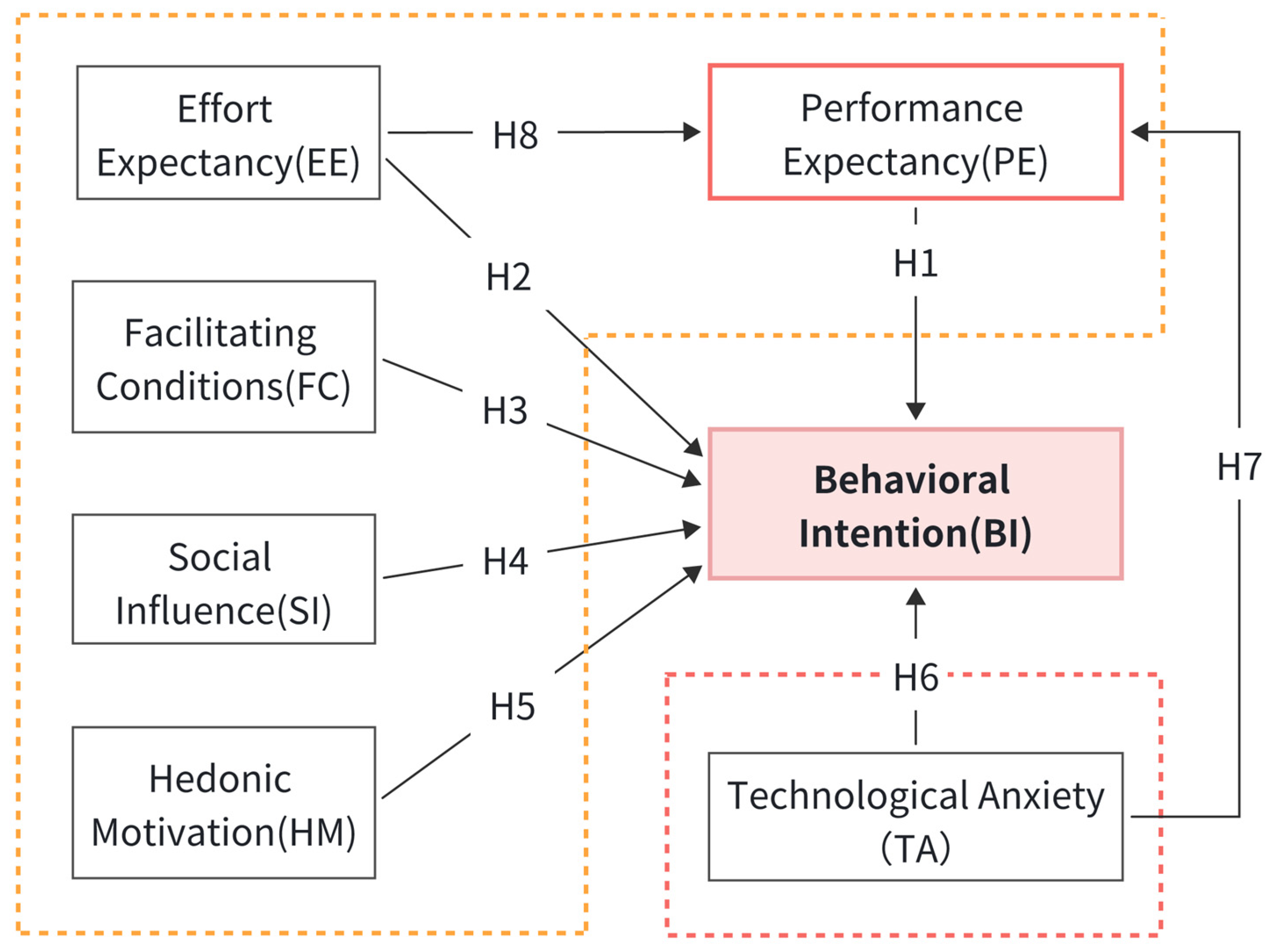




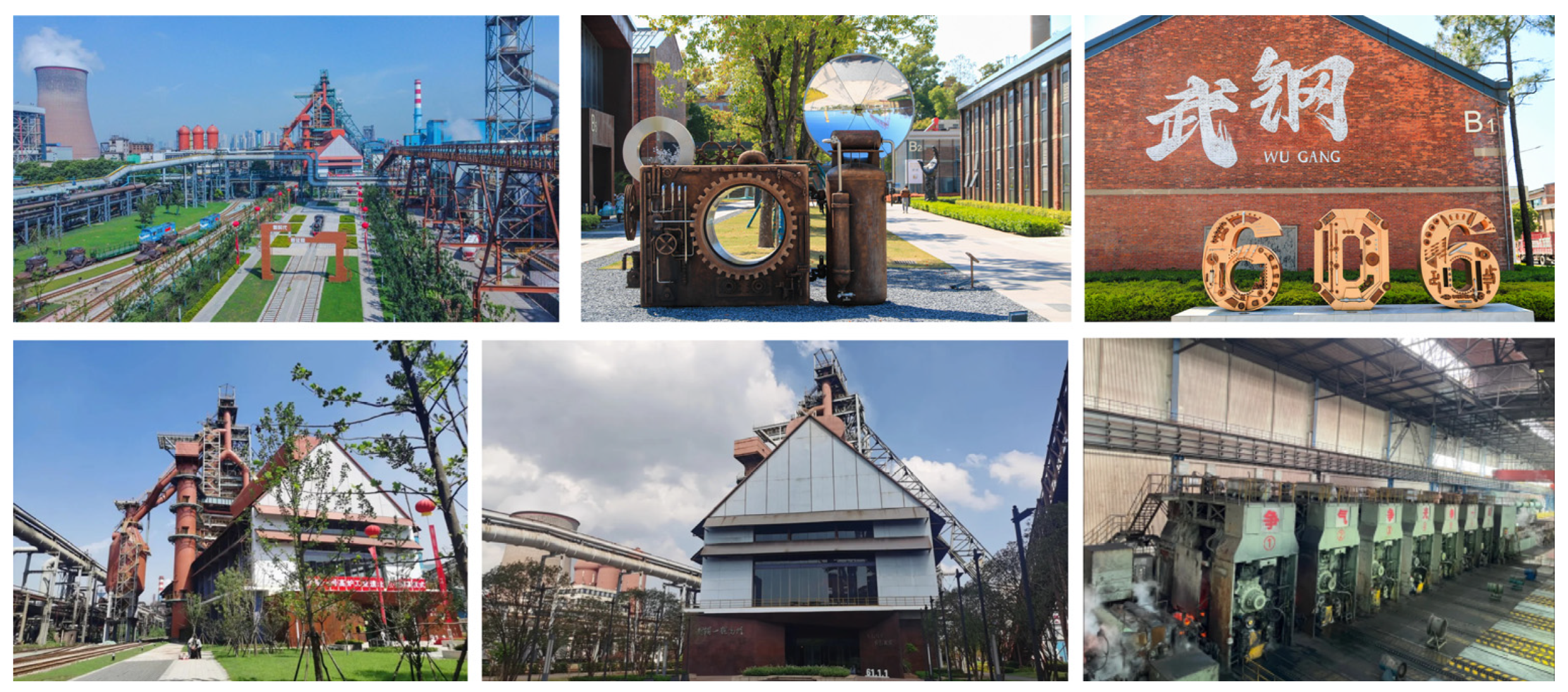
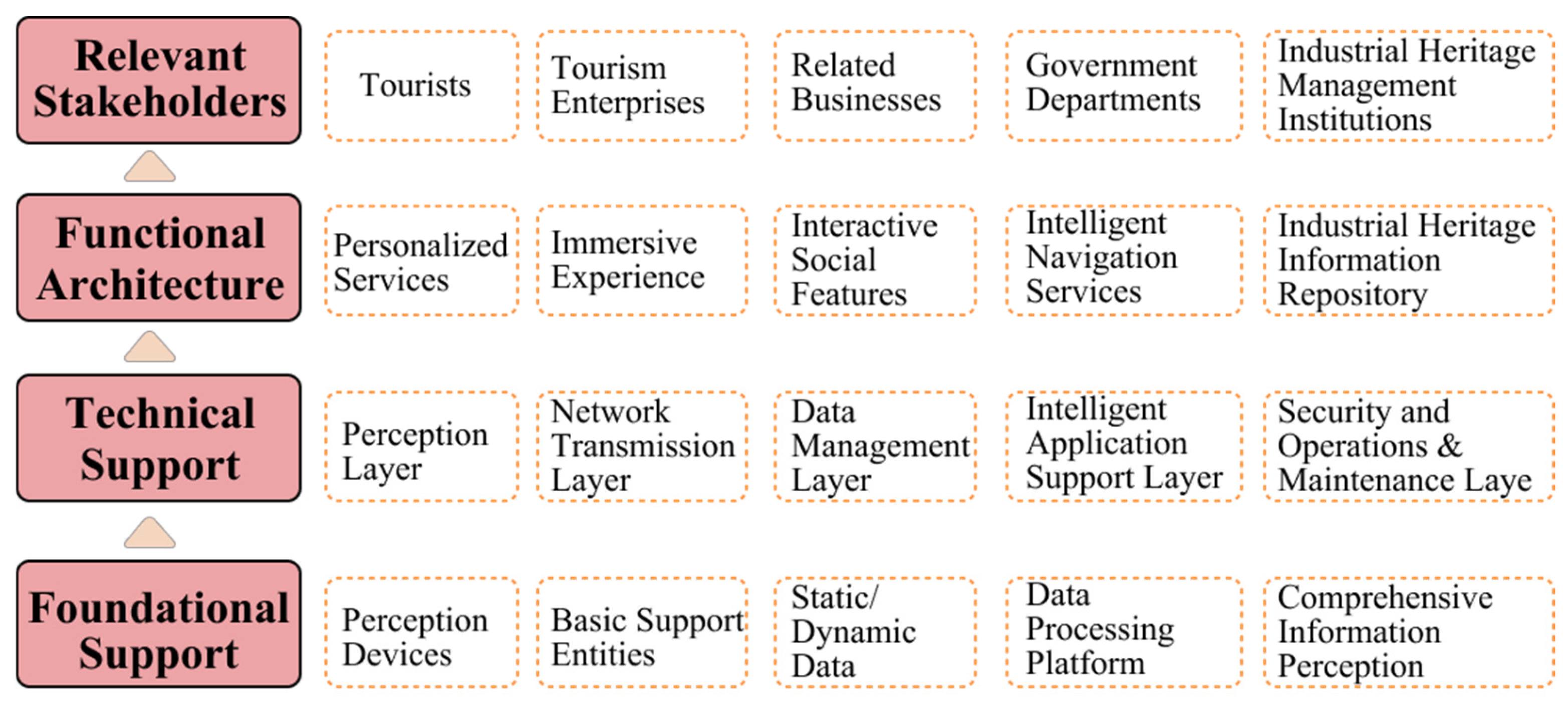
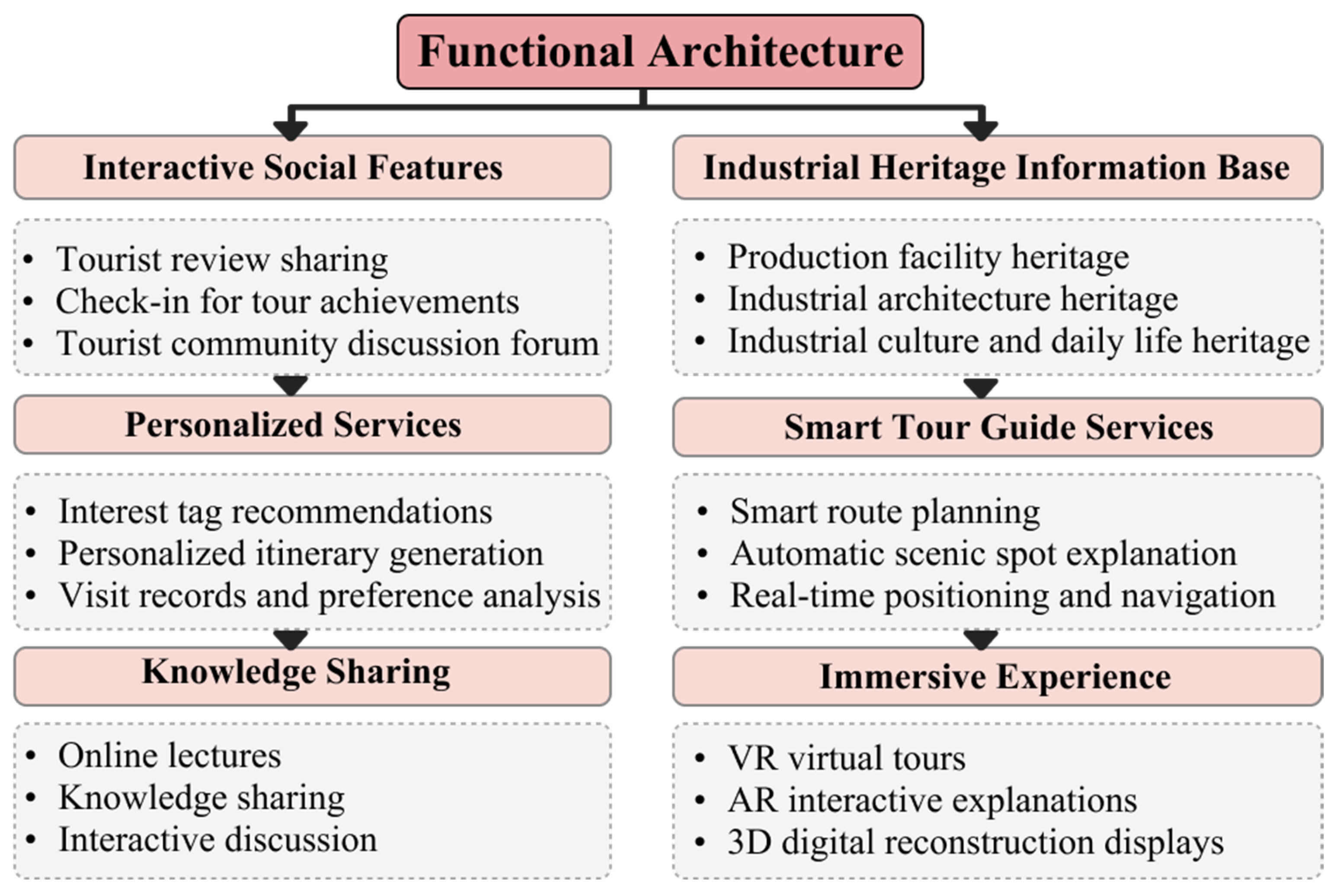


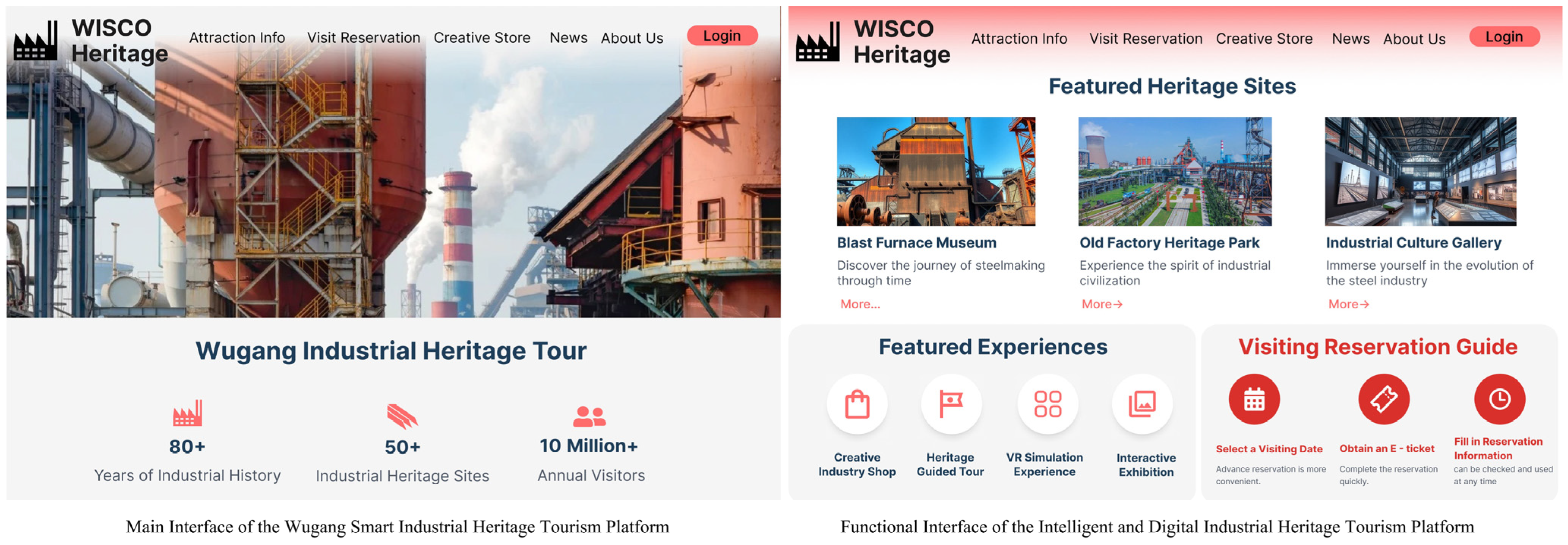
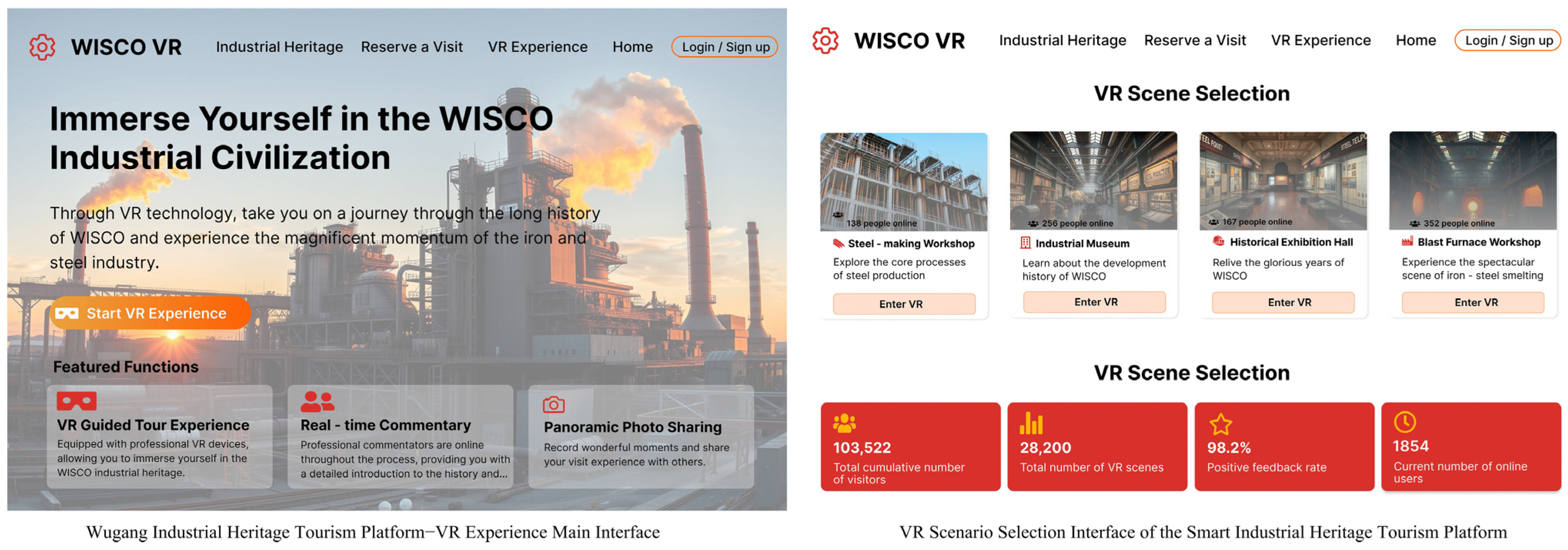

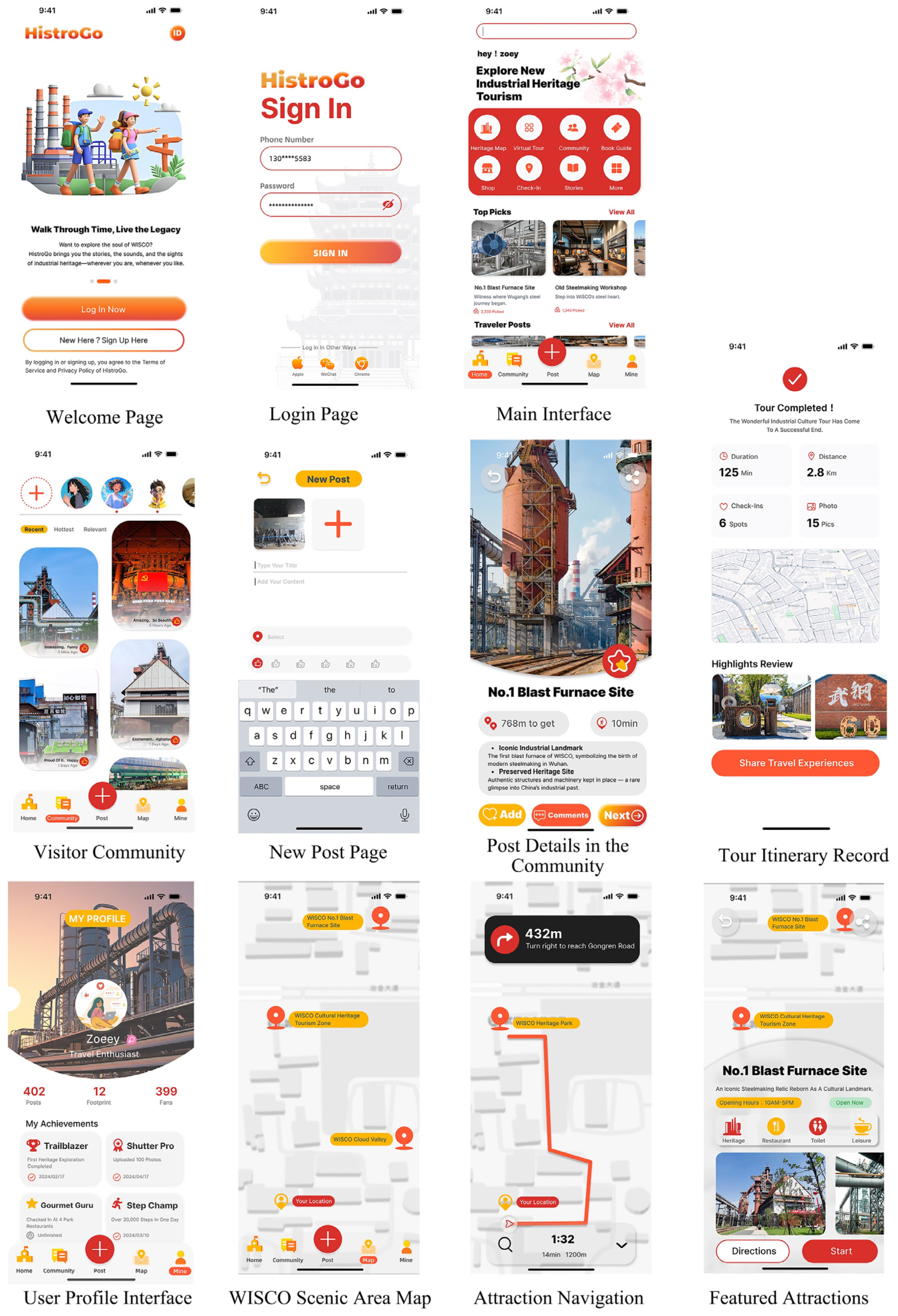
| Variable | Measure Item | Source |
|---|---|---|
| Performance Expectancy (PE) | PE1: I believe the intelligent and digital industrial heritage tourism platform will help me acquire knowledge about industrial heritage. | [33,44] |
| PE2: I believe using the intelligent and digital industrial heritage tourism platform will make it easier for me to achieve my visiting goals. | ||
| PE3: I believe using the intelligent and digital industrial heritage tourism platform will improve my tourism efficiency. | ||
| Effort Expectancy (EE) | EE1: Based on the platform’s feature descriptions, I feel that using this platform will not be difficult. | [33,56,57] |
| EE2: I believe I can quickly learn the main operations of this platform. | ||
| EE3: I am confident that I can understand the platform’s usage process and interface design. | ||
| Social Influence (SI) | SI1: If people around me use such platforms, I will be more interested in trying them. | [33,56,58] |
| SI2: People around me would recommend such intelligent and digital tourism platforms to me. | ||
| SI3: People around me think I should use the intelligent and digital industrial heritage tourism platform for online tourism. | ||
| Facilitating Conditions (FC) | FC1: I believe I have the basic knowledge or learning ability required to use this platform. | [33,56] |
| FC2: I think using this platform will not conflict with my existing devices or habits. | ||
| FC3: I believe I have the equipment and internet access needed to use this platform. | ||
| FC4: I am confident that if I encounter problems, I can get help or support from the platform or others. | ||
| Hedonic Motivation (HM) | HM1: I think the content of the intelligent and digital industrial heritage tourism platform will be interesting. | [33,59] |
| HM2: I believe using the intelligent and digital industrial heritage tourism platform will be an enjoyable experience. | ||
| HM3: I feel that using the intelligent and digital industrial heritage tourism platform will give me a sense of achievement. | ||
| HM4: I think using the intelligent and digital industrial heritage tourism platform will make me feel immersed and relaxed. | ||
| Technology Anxiety (TA) | TA1: I am concerned that using the platform’s new technological features (such as VR and AR) may be too complex and affect my visiting experience. | [53,60] |
| TA2: I feel worried about privacy and security if the platform requires access to my location or camera. | ||
| TA3: I am concerned that technical problems during the use of the platform may negatively affect my visiting experience. | ||
| TA4: I am worried that I may not be able to solve technical problems encountered while using the platform on my own. | ||
| Behavioral Intention (BI) | BI1: I look forward to using the intelligent and digital industrial heritage tourism platform. | [33] |
| BI2: I expect to use this platform over the long term. | ||
| BI3: I am willing to recommend others to use the industrial heritage tourism platform. |
| Channel | Collected | Valid | Effective Response Rate |
|---|---|---|---|
| Online | 130 | 118 | 90.7% |
| On-site | 211 | 175 | 82.9% |
| Total | 341 | 293 | 85.9% |
| Indicator | Content | Frequency | Percentage | Indicator | Content | Frequency | Percentage |
|---|---|---|---|---|---|---|---|
| Gender | Male | 143 | 49% | Education Level | Junior high school or below | 27 | 9% |
| Female | 150 | 51% | High school/Vocational school | 69 | 24% | ||
| Age | Under 18 years old | 23 | 8% | Associate degree | 47 | 16% | |
| 19~30 | 122 | 42% | Bachelor’s degree | 92 | 31% | ||
| 31~40 | 57 | 19% | Master’s degree or above | 58 | 20% | ||
| 41~50 | 45 | 15% | Occupation | Student | 80 | 27% | |
| 51~60 | 31 | 11% | Education/Researcher | 39 | 13% | ||
| 60 years old and above | 15 | 5% | Corporate Employee | 57 | 19% | ||
| Income | 0–1500 RMB | 60 | 20% | Technician | 44 | 15% | |
| 1501–3000 RMB | 51 | 17% | Freelancer | 39 | 13% | ||
| 3001–5000 RMB | 74 | 25% | Have you participated in industrial heritage tourism? | Yes | 147 | 50.17% | |
| 5001–7000 RMB | 68 | 23% | No | 146 | 49.83% | ||
| 7000 RMB and above | 40 | 14% | Are you willing to try new technologies? | Yes | 235 | 80.20% | |
| other | 34 | 12% | No | 58 | 19.80% | ||
| Main Motivation for Industrial Heritage Tourism Participation | Learning History | 86 | 29.35% | Main Motivation for Industrial Heritage Tourism Participation | Taking Photos and “Check-ins” | 76 | 25.94% |
| Parent–Child Education | 62 | 21.16% | Other | 8 | 2.73% | ||
| Interest Exploration | 61 | 20.82% |
| KMO Measure of Sampling Adequacy | 0.948 | |
| Bartlett’s Test of Sphericity | Approx. Chi-Square | 7052.318 |
| df | 276 | |
| p-value | 0.000 | |
| Construct | Number of Items | Cronbach’ α | AVE | CR |
|---|---|---|---|---|
| PE | 3 | 0.934 | 0.828 | 0.935 |
| EE | 3 | 0.928 | 0.812 | 0.928 |
| SI | 3 | 0.892 | 0.739 | 0.894 |
| FC | 4 | 0.912 | 0.723 | 0.912 |
| HM | 4 | 0.936 | 0.788 | 0.937 |
| TA | 4 | 0.899 | 0.694 | 0.901 |
| BI | 3 | 0.910 | 0.776 | 0.912 |
| Variable | PE | EE | SI | FC | HM | TA | BI |
|---|---|---|---|---|---|---|---|
| PE | |||||||
| EE | 0.750 ** | ||||||
| SI | 0.743 ** | 0.667 ** | |||||
| FC | 0.705 ** | 0.739 ** | 0.663 ** | ||||
| HM | 0.760 ** | 0.703 ** | 0.728 ** | 0.725 ** | |||
| TA | 0.439 ** | 0.458 ** | 0.250 ** | 0.281 ** | 0.348 ** | ||
| BI | 0.753 ** | 0.744 ** | 0.750 ** | 0.730 ** | 0.790 ** | 0.425 ** |
| Variable | 1PE | 2EE | 3SI | 4FC | 5HM | 6TA | 7BI |
|---|---|---|---|---|---|---|---|
| 1PE | 0.910 | ||||||
| 2EE | 0.807 | 0.901 | |||||
| 3SI | 0.799 | 0.730 | 0.859 | ||||
| 4FC | 0.764 | 0.799 | 0.730 | 0.850 | |||
| 5HM | 0.813 | 0.752 | 0.79 | 0.785 | 0.887 | ||
| 6TA | 0.468 | 0.493 | 0.27 | 0.300 | 0.377 | 0.833 | |
| 7BI | 0.812 | 0.813 | 0.825 | 0.798 | 0.860 | 0.473 | 0.881 |
| Fitness Index | Criteria for Judgment | Metric | Fitting Situation |
|---|---|---|---|
| CMIN/DF | <3 | 2.694 | Ideal |
| RMSEA | <0.05 (Ideal)/<0.08 (Acceptable) | 0.076 | Acceptable |
| NFI | >0.9 | 0.914 | Ideal |
| IFI | >0.9 | 0.944 | Ideal |
| TLI | >0.9 | 0.933 | Ideal |
| CFI | >0.9 | 0.944 | Ideal |
| Hypotheses | Estimate | S.E. | C.R. | β | p Value | Result |
|---|---|---|---|---|---|---|
| H1. PE→BI | −0.013 | 0.059 | −0.216 | −0.015 | 0.829 | Not supported |
| H2. EE→BI | 0.154 | 0.095 | 1.624 | 0.182 | 0.104 | Not supported |
| H3. FC→BI | 0.15 | 0.068 | 2.215 | 0.16 | 0.027 | Supported |
| H4. SI→BI | 0.224 | 0.059 | 3.792 | 0.252 | *** | Supported |
| H5. HM→BI | 0.333 | 0.064 | 5.211 | 0.365 | *** | Supported |
| H6. TA→BI | 0.131 | 0.035 | 3.759 | 0.156 | *** | Supported |
| H7. TA→PE | 0.047 | 0.045 | 1.054 | 0.048 | 0.292 | Not supported |
| H8. EE→PE | 0.813 | 0.053 | 15.444 | 0.828 | *** | Supported |
| Path Relationships | Effect Size | SE | 95% Confidence Interval | p-Value | ||
|---|---|---|---|---|---|---|
| LLCL | ULCL | |||||
| TA→PE→BI | Total Effect | 0.2873 | 0.0359 | 0.2166 | 0.3579 | 0.000 |
| Direct Effect | 0.0787 | 0.0287 | 0.0065 | 0.0222 | 0.007 | |
| Indirect Effect | 0.2086 | 0.0303 | 0.1495 | 0.2677 | 0.000 | |
| EE→PE→BI | Total Effect | 0.7024 | 0.037 | 0.6295 | 0.7752 | 0.000 |
| Direct Effect | 0.3862 | 0.0503 | 0.2871 | 0.4853 | 0.000 | |
| Indirect Effect | 0.3162 | 0.0481 | 0.1495 | 0.2677 | 0.000 | |
| Cultural Level | Type | Content | Representative Image |
|---|---|---|---|
| Industrial Material Culture | Production Equipment | WISCO’s 1.7 m steel rolling furnace, hot rolling mill, cold rolling mill, dust removal equipment, power generation equipment, etc. |  Hot Rolling Mill |
| Industrial Products | Iron ore, steel structure products, pipe products, industrial wire rods, construction structural steel, hot-rolled coils, cold-rolled coils, power equipment materials, etc. |  Industrial Wire Material | |
| Workers’ Tools and Supplies | WISCO workers’ safety helmets, shovels, commuter trams, soda coupons, meal tickets, various badges and medals, etc. |  WISCO “Salty Mate” Soda | |
| Architectural Relics | No. 1 Blast Furnace, hot rolling plant, cold rolling plant, office buildings, workers’ dormitories, raw material warehouses, WISCO Qingshan Red Houses, etc. |  WISCO No. 1 Blast Furnace Site | |
| Industrial Behavioral Culture | Industrial Events | 1958: Mao Zedong observed the pouring of the first batch of molten iron. 1972: Introduction of the 1.7 m rolling mill. 1997: WISCO was awarded the title of “National Quality and Efficiency-Oriented Advanced Enterprise.” |  WISCO 1.7-Meter Rolling Mill Workshop |
| Technological Processes | 1.7-m steel rolling technology, ore mining, blast furnace smelting, molten iron treatment, etc. |  Molten Iron Tapping | |
| Worker Activities | Workers’ spirit and demeanor, workplace systems, cultural and artistic activities, commendation ceremonies, celebratory events, transportation and commuting, etc. |  China’s First Female Blast Furnace Welder | |
| Industrial Spirit and Culture | Industrial Spirit | “Hardworking and Enduring Spirit”, “Three-Competitions Spirit”, “Learning-Application-Innovation Spirit”, “Red Steel Spirit” |  WISCO Worker Statue |
| First-Level Indicator | Functional Adaptability | Interface Usability | Visual Aesthetics | Emotional Resonance | Intelligent Support |
|---|---|---|---|---|---|
| Second-level Indicator | Comprehensive Information Display | Ease of Operation | Interface Harmony | Immersive Experience | Intelligent Interaction |
| Functional Matching | Clear Navigation | Aesthetic Appeal | Cultural Identification | Real-Time Responsiveness | |
| Personalized Recommendation | Learning Cost | Design Innovation | Emotional Memory Activation | Technical Reliability |
Disclaimer/Publisher’s Note: The statements, opinions and data contained in all publications are solely those of the individual author(s) and contributor(s) and not of MDPI and/or the editor(s). MDPI and/or the editor(s) disclaim responsibility for any injury to people or property resulting from any ideas, methods, instructions or products referred to in the content. |
© 2025 by the authors. Licensee MDPI, Basel, Switzerland. This article is an open access article distributed under the terms and conditions of the Creative Commons Attribution (CC BY) license (https://creativecommons.org/licenses/by/4.0/).
Share and Cite
Wei, H.; Zhu, R.; Wu, J. Promoting the Sustainable Development of Industrial Heritage Tourism Through Digital Intelligence: User Acceptance and Interface Design Research. Sustainability 2025, 17, 8432. https://doi.org/10.3390/su17188432
Wei H, Zhu R, Wu J. Promoting the Sustainable Development of Industrial Heritage Tourism Through Digital Intelligence: User Acceptance and Interface Design Research. Sustainability. 2025; 17(18):8432. https://doi.org/10.3390/su17188432
Chicago/Turabian StyleWei, Huilan, Rui Zhu, and Jinyi Wu. 2025. "Promoting the Sustainable Development of Industrial Heritage Tourism Through Digital Intelligence: User Acceptance and Interface Design Research" Sustainability 17, no. 18: 8432. https://doi.org/10.3390/su17188432
APA StyleWei, H., Zhu, R., & Wu, J. (2025). Promoting the Sustainable Development of Industrial Heritage Tourism Through Digital Intelligence: User Acceptance and Interface Design Research. Sustainability, 17(18), 8432. https://doi.org/10.3390/su17188432





